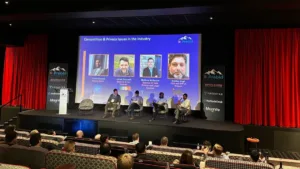Every year the big tech scene is dominated by some big narratives, some carrying far more weight than others. Here, Alexander Feiglstorfer, CTO and Co-founder of enterprise CMS Storyblok, separates the fact from the fiction among 2023’s biggest tech myths…
RIP metaverse?
Three years ago the term ‘metaverse’ was everywhere. Ever since Zuckerberg staked Facebook’s future on building an immersive 3D world, it dominated the conversation and set off a step-change in innovation as techs scrambled to be the first to establish ‘the next iteration of the web.’
Today though, as with any hype cycle, the initial fervour has worn off and Meta’s ‘metaverse’ vision has taken a tumble amid widespread layoffs and investor pull back. Cue the inevitable headlines – ‘RIP metaverse.’
But just because fascination with the metaverse has subsided, that’s far to say it’s destined to die a death altogether. After all, it’s important to remember that the metaverse is much more than just Meta’s version. It is much better defined as the ultimate goal of a whole suite of virtual and augmented reality propositions that will change how we interact online – and it’s predicted to into a $783.3 billion market by next year.1
Nike now sells virtual trainers, H&M has a virtual showroom, Burberry’s launched a metaverse game and Coca-Cola has landed in Decentraland. At the same time a vibrant ecosystem of VR infrastructure startups has been created that are drastically reducing the cost and complexity of VR experience creation.
With this, we’ll likely see more brands and marketers taking advantage of metaverse-ready experimental and immersive technology, such as AR and VR, as a way to interact with consumers in more meaningful ways.
Apple’s VR headset will fail
That takes me nicely onto another important tech category – VR. For years, the tech sector has waited with baited breath for the arrival of Apple’s VR headset, widely considered to be the game changer of XR – the hardware that finally takes VR into the mainstream.
After its recent unveiling, though, the buzz has subsided and been replaced with a rather critical glaze. Foremost, there’s the hefty $3,000 price tag Apple slapped on to it which is likely to put it out of reach for potential VR converts. Moreso, the consensus is that other VR contenders, such as Quest 3, offer much of the same key functionalities at a more accessible price. Again though, that’s not to say we can afford to judge it too soon.
After all, if the tech sector has taught us anything then surely it’s that major innovation leaps can go through multiple ‘winters’ before becoming a mainstream hot property?
Also, it’s likely that as demand increases, costs will come down and more affordable adaptations become available. In the meantime, the good news is the Apple headset will continue to serve as an impetus for the wider market, driving other entrants to think bigger and bolder to compete in the race for the VR space.
Gen AI will transform martech – instantly
It’s easy to see why Open AI’s breakthrough ChatGPT has brought gen AI to the fore with its scarily accurate ability of understanding natural human language and generating detailed human-like written text. What’s more, it can write content, proposals and poetry. According to various trials it can even write college-worthy essays and pass university-level exams.
Cue endless debate as to its ability to revolutionise content creation, marketing, customer support – and instantly. Indicative of this, earlier this year several marketing companies announced they planned to lay off staff in the face of gen AI automation – a position that looks increasingly premature.
The reality is that ChatGPT and other gen AI applications are far from the finished article. Ultimately, any type of gen AI tech is still only as accurate as the information it is provided. Yet the world is constantly changing and information evolving, leaving wide scope for inaccuracies, hallucinations and manipulation. Further concerns surround the potential for inherent bias, security breaches and questionable legal standing. Thus, while certainly a powerful tool with a lot of potential, gen AI is far from match ready and will take a lot longer to become fully integrated into businesses.
Composable is complex
For most businesses, time is money and maintaining business as usual is a top priority, especially in the current climate.
Understandably then, some might be less inclined to transition from a monolithic tech stack to a composable one – essentially, an architecture which combines API-first microservices on the cloud – due to a commonly held belief that it requires a lot of change resulting in costly disruption and downtime.
The good news is this is far from the case. In reality, the longest part of any migration is usually the initial planning stages – reviewing assets, choosing the most suitable provider, preparing employees and end-users.
So long as it is well planned, it’s possible to conduct a ‘lift and shift’ model where the migration takes place in just a few weeks while maintaining operations. Also, it means you’ll no longer be confined to a big, all-in-one software solution, and can pick and choose the pieces of tech that best serve your needs. This approach not only vastly reduces costs, speeds up development and is incredibly flexible but will become ever more important for helping businesses keep up to speed with the fast-evolving modern marketing mix.
1 Forbes









